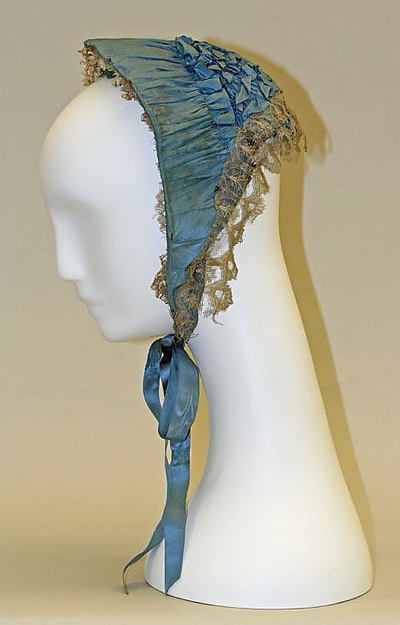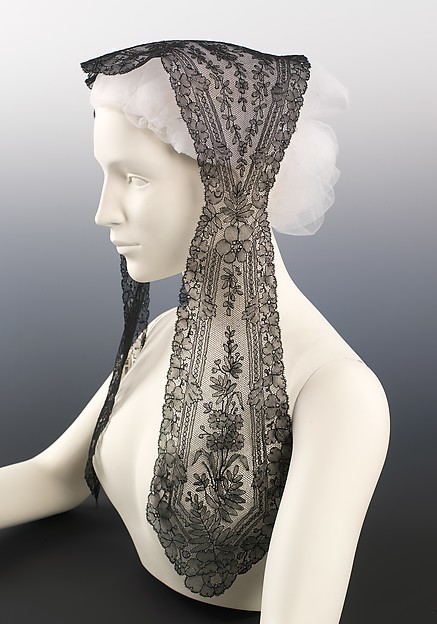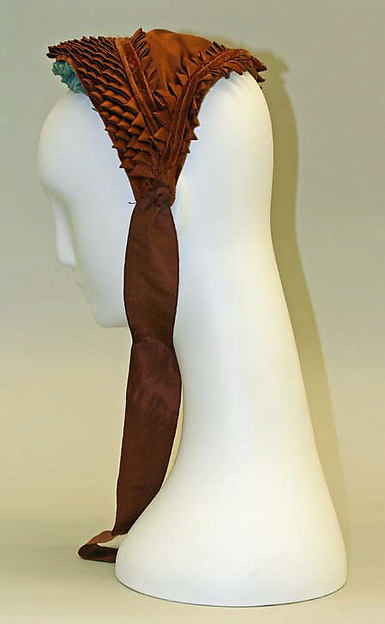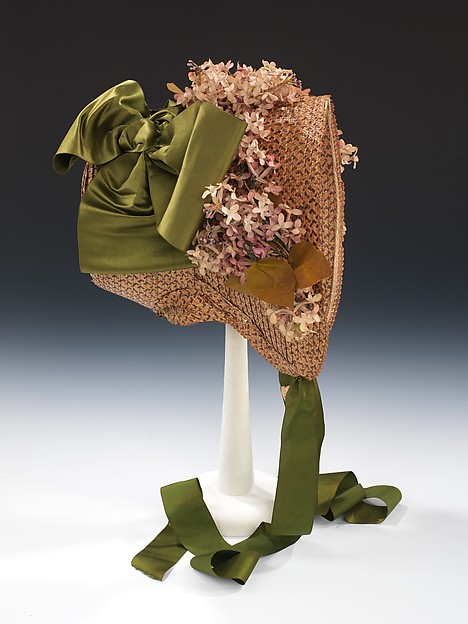Still working on '65 ensembles. My bonnet research has gotten ridiculous, so I'm posting the first part of it alone (pattern-drafting adventures to follow).
In period illustrations and descriptions:
 |
| New Style Bonnets, from Peterson's Magazine, February 1865 |
Notes: Brim low on the head, cut in one piece with the crown, short curtain/decorative trim, cheek tabs still in evidence. Contrast with the previous year, which had more substantial bavolets, and higher brims (whether in one crown-brim piece, or with two separate ones). External trim placement has also shifted.
 |
| Bonnets from Peterson's, February 1864 |
Back to 1865:
 |
| Peterson's, April 1865 |
The April '65 bonnets still have the same general shape as February (tabs extending past the ear and down the cheek; brim moderate, lower than the previous year, but still has room for some decoration; crown and brim cut in one piece), with even less of an obvious curtain. The fashion illustration below (from the same issue), however, still shows a slight curtain, as well as trims under the brim, on the outside of it towards the back, and trailing down behind the bonnet
 |
| April 1865, Peterson's Magazine |
And then another change comes between April and May:
 |
| From Peterson's, May 1865 |
 |
| Another bonnet from Peterson's, May 1865 |
 |
| A third bonnet from Peterson's, May 1865 |
The May bonnets are "very small and have no crowns"; they fit "rather close to the head", and "admit no cap, only a bit of lace put on with a slight fullness" at the sides of the face (continuing a trend over the previous decade of shifting under-brim decoration from beside the face to above it). Compared to the April numbers, the crown does seem to be omitted, but small curtains (or edge trim suggestive of curtains) are more in evidence than they were the previous month, perhaps easing the the transition to the new crown-less shape.
 |
| Bonnet, from Peterson's Magazine, June 1865 |
Coming into June, the shape follows similar lines: no crown, but the brim still extends a bit to the back, slight hint of a back ruffle which suggests a curtain, brim close to the sides of the face, and still peaking up above the forehead.
 |
| Peterson's, July 1865 |
This bonnet from July looks almost like a visor: just the brim and trimmings. I like the repeated bird motif on the ties. The tabs still appear to extend down the face.
 |
| Peterson's, July 1865 |
 |
| Peterson's, July 1865 |
As worn, the July bonnets show that tabs still extend down the cheek, with the front brim close to the face at the sides and raised above the face at the top. The hair is dressed low in the back to fill-in for the absent crown; between June and July, the rear section of the brim appears to have shrunk/raised slightly, giving more space to the hair.
And the bonnet play-by-play from Peterson's Fashion Section:
 |
| Jan 1865 |
 |
| May 1865 |
 |
| June, 1865 |
 |
| August, 1865 |
 |
| From Peterson's Magazine, Sept 1865, page 218 |
The referenced (reviled) Empire Bonnet:
 |
| Peterson's, September 1865 |
(Edited to add: the author of
Arthur's Illustrated Home Magazine actually likes this style of bonnet, finding the fanchons "common" and the waterfall hairstyle they accommodate "never very tidy".)
And now for some originals:
Notes: rounded triangle shape; cheek tabs maintained. slightly raised brim; no crown; decorative edging/minimal bavolet. Fits in with the illustrations and descriptions of fanchons in Peterson's for the summer of '65.
(
More "fanchons", of the silk lace variety, from the Met). I believe these to be indoor caps and headdresses, rather than bonnets. To quote from Peterson's again:
 |
| Peterson's Magazine, February 1865 |
Another of the "bewitching three-cornered" bonnets. Compared to the blue article above, the "cheek tabs" are shorter (end around eye-level on the mannequin, instead of being on level with the lips); front brim still rises above the head, allowing for some decoration beneath; no crown, bonnet does not extend past the back of the head; no curtain/bavolet. The shape could be appropriate to the summer of '65, but I think that longer cheek tabs would make it look more like the illustrations; the addition of a minimal curtain at the back would bring it more in line with the April 1865 illustrations.
The two originals above have a lot in common with this "half bonnet" c. 1870 from the Museum of Fine Arts, Boston:
Given the dates are ranges on all three... Anyway, they share a number of similarities with each other and the 1865 illustrations (triangular shape, no crown, lower brim). The cheek tabs on this straw-and-green bonnet , as on the orange one, are shorter than the blue example and the illustrations, which leads me to suspect that they are later than '65 (the blue may be '65).
Crown-less, curtain-less bonnet, tagged as "child's". I'm curious about how long the cheek tabs are (ie, would like to see this on an appropriately-sized model head).
Some British bonnets:
Long cheek tabs, crown and brim cut together, no curtain (but ties are run along the lower edge in a sort of homage to a curtain): spring '65?
The cheek tabs and curtain-like trim remind me of the late spring '65 illustrations, as the crown morphs into the brim and then vanishes. Here's another like it, with two sets of ties surviving:
A silk crepe bonnet from the Henry Ford Museum (not sure what's going on with the tabs, but the "visor" shapes reminds me of the summer of '65 pictures):
Then there are these two examples from the Met, dates c. 1865 and c. 1866, which I'm not sure how to interpret:
The lack of curtains does suggest an 1865+ date, but the presence of crowns and the low brims make me think "late 1850s to early 1860s" (before the high brim 'spoon' bonnet shape rather than after it); the cheek tabs are still low, as in the first blue fanchon and earlier styles, suggesting a pre-1870s date. These examples are straw; perhaps they originally had silk curtains which were later lost, or removed to update the article? Perhaps something altogether different is going on?


























No comments:
Post a Comment
Thanks for commenting!